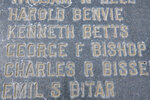

On July 28, 1942, U.S. Army Sergeant George Frank Bishop, of Centralia, died at the Imperial Japanese Cabanatuan POW Camp in the Philippines. His body was buried with thousands of others in one of the camp’s mass graves.
Thanks to the efforts of the Defence POW/MIA Accounting Agency and the Armed Forces Medical Examiner System, his remains were finally identified almost 82 years after his death in June 2023. Bishop will be laid to rest in Chehalis next month.
Bishop’s burial ceremony will begin at 1 p.m. on Thursday, May 23, at Claquato Cemetery, located at 142 Stearns Road. The public is invited to attend.
The Chronicle reached out to Bishop’s closest surviving relative, his nephew, Stanley Yocom, of Chehalis, himself a U.S. Navy Vietnam War veteran, to talk about the upcoming burial.
Now 75, Yocom noted he hadn’t been born yet when his uncle died, but his mother would talk about him when he was growing up.
“She would always talk about Uncle George, her brother, about how he had been lost in the Philippines,” Yocom said.
What little his mother did know of Bishop’s fate she was told decades ago by U.S. Army personnel.
Born on Jan. 25, 1920, in Centralia, Bishop enlisted in the U.S. Army on Dec. 29, 1939, just before his 20th birthday, according to a Defence POW/MIA Accounting Agency news release and records on findagrave.com.
After getting stationed at Fort Lewis, Bishop deployed and was attached to “K” Battery of the 59th Coast Artillery Regiment at Fort Mills on Corregidor Island — located at the entrance of Manila Bay on the Island of Luzon in the Philippines.
There, he helped operate fixed seacoast 3-inch artillery guns facing Bataan to the north, along with 30-inch and 60-inch searchlights used to illuminate mine markers in Manila Bay.
On Dec. 22, 1941, Imperial Japanese forces invaded Luzon, and bitter fighting ensued over the next four months until Bataan fell on April 9, 1942, followed by the fall of Fort Mills and Corregidor less than a month later on May 6.
Bishop was officially listed as missing in action the following day. Along with his fellow American and Filipino soldiers, Bishop was forced on the infamous 65-mile Bataan Death March before being sent to the Cabanatuan POW Camp in central Luzon.
Being a POW meant being subjected to inhumane conditions on top of being starved and denied clean drinking water.
It wasn’t long before Bishop contracted diphtheria and dysentery and died in the prison’s hospital on July 28 at the age of 22. He was buried in Cabanatuan’s Common Grave 215.
According to prison hospital records accessed after the Cabanatuan POW Camp was liberated in early 1945, Bishop was one of 22 prisoners who died that day. More than 2,500 American prisoners died at Cabanatuan throughout WWII.
After the Imperial Japanese surrendered and WWII ended, any remains that could be found at Cabanatuan were disinterred by the American Graves Registration Service (AGRS) and brought to a temporary U.S. military mausoleum near Manila to attempt to identify them in 1947.
Five bodies from Common Grave 215 were identified, but the rest were declared unidentifiable and buried at the Manila American Cemetery and Memorial as Unknowns.
Bishop’s old U.S. Army Individual Deceased Personnel File stated, “George is most likely buried in the Manila American Cemetery as a ‘Known but to God.’ There are 953 men like Sgt. Bishop who were not identified after the war, ‘Unknowns,’ permanently interred in the Manila American Cemetery from Cabanatuan.”
The grave of the Unknowns at the Manila American Cemetery is cared for by the American Battle Monuments Commission.
While in the Navy himself, Yocom served aboard the U.S.S. Winston Andromeda-class attack cargo ship in 1965, just north of Manila Bay on Luzon.
“I spent a year in Subic Bay in the Philippines, and I didn’t even know he was there,” Yocom said.
In 2018, renewed efforts by the Defence POW/MIA Accounting Agency and scientists from the Armed Forces Medical Examiner System used mitochondrial DNA and y-chromosome DNA analysis to positively identify Unknown remains.
“DNA finally caught up with him, and they identified him from my DNA,” Yocom added.
With the funeral scheduled in Chehalis next month, Claquato Cemetery Manager Lacie Jendryka has been assisting Yocom and the rest of his family with arrangements, but they have run into one issue — nobody can find a photo of Bishop.
“We have no pictures,” Yocom said.
Yocom added Jendryka has even checked the records of all high schools in Centralia at the time, but no records of Bishop attending, let alone photos, seem to exist. According to WWII U.S. Army documents, Bishop “completed four years of high school.”
Yocom’s mother also left him a small Filipino doll and a postcard, which Yocom believes are the last correspondence Bishop was ever able to send before being captured.
“It’s a Christmas card, and I’m thinking that it has to have been mailed in 1939 or 1940, because in ‘41 at Christmas time, the Japanese had already invaded (the Island of Luzon),” Yocom said.
The card depicts two Filipinos working a field with water buffalo along with saying “season’s greetings.” It is addressed to Yocom’s mother.
He plans on making it the centerpiece of a shadowbox he is having made for Bishop to display at his funeral.
Yocom also asks anyone who thinks they might have a photo of Bishop to reach out to Jendryka at lacie@claquatocemetery.com.
For more information, read the Defense POW/MIA Accounting Agency’s news release at https://bit.ly/3TOIf7B or visit https://bit.ly/4aHxgUr.